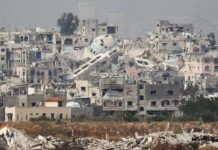
DM Monitoring
TEHRAN: Iranian military has staged a series of drills since the beginning of the year, as it prepares for any possible contingencies amid its rising tensions with the U.S. government in the last days of Donald Trump’s presidency.
The latest military exercise took place on Wednesday and Thursday, with the Iranian Navy staying a drill, codenamed Eqtedar-e Daryayi (Naval Strength) 99, along the Makran coasts in southeast Iran and north of the Indian Ocean.
Tehran started its latest wave of wargames on Jan. 5 with a novel large-scale drone exercise in Semnan province, after two weeks of escalating tensions marked by the first anniversary of the U.S. assassination of Qassem Soleimani, former commander of the Quds Force of the Islamic Revolution Guards Corps (IRGC).
Iran’s Foreign Minister Mohammad Javad Zarif warned on Dec. 31, 2020 of an alleged plot by Trump to attack Iran, right after the U.S. president gave the order to fly two B-52 bombers to the Middle East as a “deterrence message.”
The deployment was supposed to deter Iran from taking any action to fulfill the vows renewed by Iranian officials to punish the perpetrators of Soleimani’s assassination on Jan. 3, 2020. Incumbent commander of the Quds Force, Esmail Qa’ani, praised his predecessor before the anniversary in a speech, in which he warned Washington that retaliation could take place “from inside your own house.” Shortly before the two-day drone exercise was staged, Hossein Salami, commander in chief of the IRGC, declared that Iran would respond to any possible U.S. attack with a “reciprocal” strike.
According to the data officially released, the Iranian military tested hundreds of drones of different kinds in the central province of Semnan, belonging to the ground, air and naval forces.
The training operations included interception and destruction of air targets using air-to-air missiles, destruction of ground targets using bombs and point-to-point missiles, and widespread use of suicide drones, Deputy Chief for Operations in Iran’s Army Seyyed Mahmoud Mousavi declared.
One day before the launch of the series of drills, Iranian authorities kept issuing warnings. Saeed Khatibzadeh, spokesman of Iran’s Foreign Ministry, declared on Jan. 4 that Tehran was closely monitoring the movements of U.S. warships in the Gulf, and would respond if its interests were attacked.
Similar admonitions were addressed also to Tel Aviv, after Israeli Prime Minister Benjamin Netanyahu said on Jan. 4 that Israel would not allow Tehran to develop nuclear weapons, once Iran resumed 20 percent uranium enrichment.
The Iranian show of force continued last week on Jan. 7, when Basij, an IRGC’s force of volunteers, held a naval parade on the shores of Assaluyeh port in the Gulf, attended by more than 700 light and heavy vessels. The next day, Salami gave a televised speech when unveiling a new underground missile base in Hormozgan province, north of the Gulf and the Strait of Hormuz.





